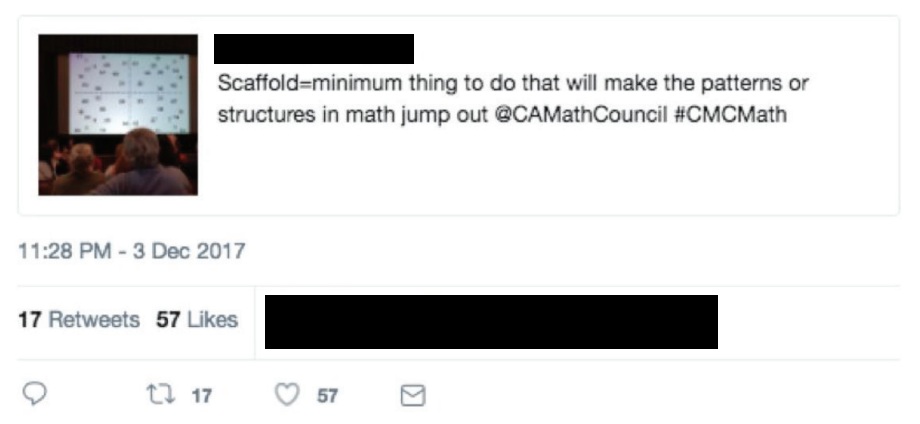Karen Wootton, Director of Curriculum & Assessment, karenwootton@cpm.org
Last year, a tweet came to my attention when it made the rounds in the Twittersphere:

It made me wonder what most teachers think scaffolding is. Would most agree with the tweeted definition? Or would some define scaffolding with something more specific and concrete?
So I posed the question on social media: What is scaffolding? Before you read some of the responses, answer this question yourself.
Here are some of the answers:
“Structuring problems to build on one another.”
“Providing supports a student needs to do the task.”
“Unfortunately, it can be and often is a way to help struggling students pass without understanding what’s going on.”
“It is an attempt to structure and sequence the learning; the attempt is to make the learning easier for the students. It is the exact opposite of [Jo Boaler’s] rich problem and group based math learning techniques. It is an attempt to do the student’s thinking for them.”
“I think that is how we usually see scaffolding implemented, but ideally supports (i.e. clarifying, probing, or extension questions) should strive to avoid taking over student thinking.”
“Enable students to access higher concepts, like allowing student who struggle with times tables to use calculators so they can interact with proportion/percent/probability ideas.”
Each of these responses helped me think further about scaffolding, and I have tried to come up with a way to describe it so that scaffolding makes sense and is easier for everyone to understand. Because scaffolding is a building term, it makes sense to continue with that analogy.
Imagine that a student is seen as the builder of his or her own knowledge. The student builds this knowledge structure in a number of different ways: through play, conversations, actions, practice, etc. Everything the student does helps to build the structure.
Sometimes the building process becomes difficult, and the student might struggle to continue with the building. At that point, it might be helpful to the student to have support, without taking over and finishing the building for them. Maybe the student just needs another hand to hold something in place. Another time the student might need a platform to allow them to reach higher. Maybe the student will help someone else build their structure and learn from that experience. No matter what the reason for the support, we should understand that the goal is for the support to be temporary. Once the support has done its job, the student can continue to build upon what they learned while the support was in place. It is also important to note that just as scaffolding does not take the place of the building under construction, scaffolding should not take the place of the student knowledge under construction. The student still needs to work, and the cognitive demand should not be lessened because of scaffolding.
In working on CPM’s intervention course, Inspirations & Ideas, numerous times the writing team struggled with the amount of scaffolding the materials should provide. A guiding principle for the team is this notion: You can always provide further support, but once given you cannot always remove what was given. The writing team made the decision that most of the student support would not be in written form in the student text, but rather, the teacher materials would provide suggestions on how to support students in order to encourage productive struggle. The teacher materials offer pocket questions, suggested Study Team and Teacher Strategies, manipulative use, plus more, to scaffold (that is, support) student learning. The use of all of these supports are at the discretion of the teacher, who can add more if needed. Scaffolding does not need to be written, but can occur through questioning, explaining to others, or by using manipulatives.
Every teacher should have an arsenal of ways to support student learning at their disposal. These scaffolds can take many forms, but with any form you choose, start with the minimal amount of support necessary. Remember, you can add, but you cannot subtract.

